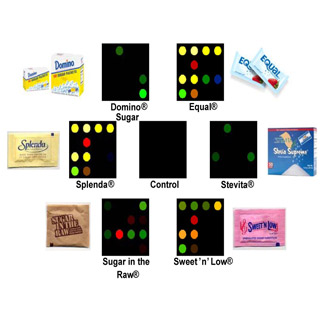
By using easy-to-read color markers, the novel sensor can apparently identify natural and artificial sweet substances including 14 common sweeteners with 100 percent accuracy. This may be a boon to all the food processors as they can now ensure that their products like soda pop, beer and other beverages taste great and have the standard constant flavor. This ‘sweet-tooth’ sensory can be used as a simple quality control test.
This new sensor is the size of a business card. The sweeteners in solid foods like cakes, cookies and chewing gum can also be identified by the sensor. The researchers mention that probably in the future doctors and scientists could use the modified versions of the sensor for chemical-sensing applications ranging from observing blood glucose levels in people with diabetes to spot toxic substances in the environment.
Research leader Kenneth Suslick, Ph.D., of the University of Illinois at Urbana-Champaign comments “We take things that smell or taste and convert their chemical properties into a visual image. This is the first practical ‘electronic tongue’ sensor that you can simply dip into a sample and identify the source of sweetness based on its color.â€
For years researchers have attempted to develop ‘electronic tongues’ or ‘electronic noses’ that compete or even outdo the sensitivity of the human tongue and nose. One of the drawbacks of this device is that it can apparently have difficulty in distinguishing one chemical flavor from another especially if it is of a complex mixture. This restricts the practical applications of the earlier technology.
The device consists of a strong, glass-like container with 16 to 36 minute printed dye spots; each of it is the diameter of a pencil lead. A color change is produced when the chemical in each spot reacts to sweet substances. The type of sweetener determines the color and the amount of sweetener determines the intensity of the color.
These findings were revealed at the American Chemical Society’s 238th National meeting.
